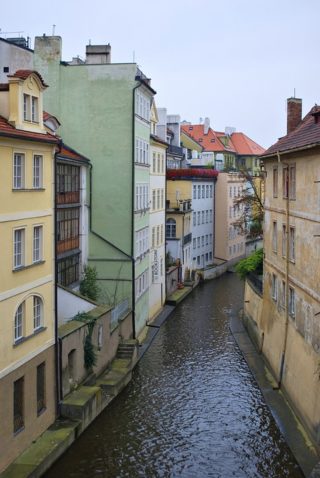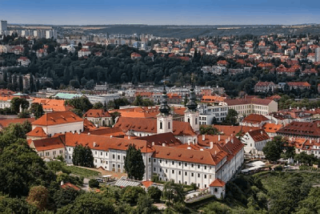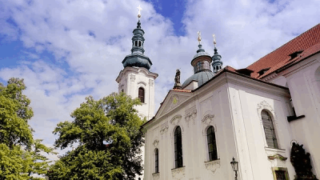St Vitus Cathedral
The history of St Vitus cathedral reaches back to the 10 th century when the first Romanesque
rotunda was built. After 1060 the rotunda was converted into a considerably larger basilica with
three ailes and two choirs. However the origin of the present-day cathedral dates back to 1344
when the foundation stone was laid. It was in the presence of King John (the Blind) of Luxembourg,
Charles IV, his brother John Henry and the first archbishop of Prague, Arnost of Pardubice.
But why was the cathedral built in the first place?
Well, in 14 th century the Prague bishopric was elevated to the archbishopric. The first architect who
started the construction of the Cathedral was Matthias of Arras. Unfortunately he died prior to the
completion of his masterpiece. Initially, the eastern chancel, used for a celebration, was built. Eight
chapels were situated in the horseshoe shaped chorus. In the south of the cathedral we find the Chapel
of the Holy Cross. The second achitect who’s task was to finish the cathedral was Petr Parler. He came
to Prague at the age of 23 years, and, unusual for the time he used a tracery vault inside the cathedral.
Petr Parler completed the lower chapel and constructed the high choir with a net vault and its complicated
supporting system. Although it is known as a ‚ribbed vault of Parler's type‘, in fact it‘s a wagon
vault, cut for windows and beautiful ornamentation.
St Wenceslas chapel
St Vitus Cathedral was designed as a three aisled cathedral with a transept and triforium and of course
nineteen fabulous chapels. The most famous one is St. Wenceslas chapel which is built on the
site of the southern apse of the Wenceslas rotunda in which the prince was buried. The chapel was
built between 1362 and 1367 to house the relics of the saint. The lower part of the walls is decorated
with 1345 semi-precious stones of Bohemian origin. There are also beautiful paintings on the theme
the Passion of Christ. Above the St Wenceslas chapel, we find a Crown Chamber situated where
the coronation jewels of Bohemian Kings are stored. The upper part is covered with 31 scenes depicting
the life of St Wenceslas and represent the work of the Master of the Litoměřice Altarpiece between
1506 and 1509. In the middle of the wall there is a Gothic statue of St Wenceslas which was made by Jindrich
Parler,who was the Peter's nephew, in 1373. Unfortunately the Chapel is not accessible to the public
you could see its interior only from the doorways. A forged door with seven locks which is located
in the south-western corner of the chapel, leads to the Crown Chamber containing the Bohemian
Coronation Jewels.
After Parler’s death
For five years after Parler's death nobody worked on the cathedral until 1399, when the construction
of the steeple was continued by his sons. The Hussite revolutionary movement prevented any further
construction of the cathedral for a number of years. After the great fire of 1541, the whole Prague castle
complex had to be re-constructed. After that it was re-opened. Baroque parts of the cathedral were
introduced in 1770. On the southern facade of the cathedral you will find a beautiful mosaic in the theme
of The Last Judgement, which is very unusual for this region.
18. and 19. Century of St. Vitus Cathedral
The western facade is dominated by 82-metre high towers from 19 th and 20 th century, by
Josef Mocker. The work was finalised by Kamil Hilbert because of Mocker's untimely death in
1899. St Vitus Cathedral was consecrated in 1929 on the occasion of the millenium anniversary of St.
Wenceslas‘ murder. With the exception of the coronation jewels, the cathedral houses the
mausoleum of Bohemian kings and gallery of sculptures and portaits. We should point out that
many famous names participated in the construction and the artistic decoration of the St Vitus
Cathedral – Frantisek Kysela, Max Svabinsky, Alfons Mucha, Karel Svolinsky, Otakar Spaniel, etc.
Legends of St. Vitus Cathedral
There are also many legends associated with St Vitus Cathedral. Unlike most Czech castles, Prague
castle is not known to be haunted as such, although there are stories about a ‚white spirit; which
supposedly had the ability to predict the future.
Another legend states that if Zikmund‘s Bell is damaged, then the disaster will follow. This legend
actually came true when Zikmund's bell broke, huge floods came in 2002.
But te most famous legend is associated with the coronation Jewels. The story goes that if anybody
unworthy or wearing the crown does so, they will be dead within a year and a day. This was the
case of Rheinhard Heydrich, Reichsprotektor of Bohemia and Moravia during World War 2, who
reputedly put the crown on his head. Two days later he was assassinated.
Petr Parler
Petr Parler was a German architect who was famous for being the builder of Saint Vitus Cathedral
and Charles Bridge in Prague. His father, Heinrich Parler was a master builder. Heinrich moved to
Schwäbisch Gmünd from Cologne where he supervised the reconstruction works of the Holy Cross
parish church. All members of the large Parler family worked in construction works all over the
Europe at some time. Petr Parler became the master mason of St Vitus Cathedral in 1352 after the
death of its original architect Matthias of Arras . As well as the cathedral he was the main architect
of the New Town of Prague and Charles Bridge and its towers. In the famous Royal Palace of Prague
Castle Parler, he built the All Saints' Chapel. After the fire in 1541 it was reconstructed in the
Baroque style. He was apparently the architect of the Church of Our Lady which was built in the
market square of Nuremberg. It replaced the synagogue torn down in the pogrom of 1349 which
was followed with the plague. Between 1360-78 Parler built the beautiful chancel of the St.
Bartholomew church in Kolín . He died in Prague in 1399 and he was buried in the St. Vitus cathedral.
If you want to sleep few minutes from the Prague Castle, book one of our cosy private double rooms!













